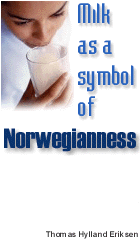|
|
 The people
The people
|
Copyright © 1994-2002 Encyclopedia Britannica, Inc.
Ethnic, linguistic, and religious composition
In most parts of Norway the nucleus of the population is Nordic in heritage and appearance. Between 60 and 70 percent have blue eyes. An influx of people from southern Europe has been strong in southwestern Norway. Nord-Norge has about nine-tenths of the 20,000 to 30,000 Sami (Lapps, or Laplanders) living in Norway. Only about 2,800 of them still live on the Finnmark Plateau and move their reindeer herds down to the coast for summer grazing. The Sami were Norway's first inhabitants; they arrived at least 10,000 years ago, probably from Central Asia.
The language of Norway belongs to the North Germanic branch of the Germanic language group. The Norwegian alphabet has three more letters than the Latin alphabet—?, o, and a, pronounced respectively as the vowels in bad, burn, and ball. Modern Norwegian has many dialects, but all of them, as well as the Swedish and Danish languages, are understood throughout all three of these Scandinavian countries. Until about 1850 there was only one written language, called Riksmal, or “Official Language,” which was strongly influenced by Danish during the 434-year union of the two nations. Landsmal, or “Country Language,” was then created out of the rural dialects. After a long feud, mostly urban-rural in makeup, the forms received equal status under the terms Dano-Norwegian (Bokmal, or “Book Language”) and New Norwegian (Nynorsk), respectively. For more than 80 percent of schoolchildren Dano-Norwegian is the main language in local schools.
About nine-tenths of all Norwegians belong to the Evangelical Lutheran national church, the Church of Norway, which is endowed by the government. The largest groups outside this establishment are Pentecostals, Roman Catholics, Lutheran Free Church members, Jehovah's Witnesses, Methodists, and Baptists. As a result of Asian immigration there also are small groups of Muslims and Buddhists.
Demographic trends
Largely as a result of a significant increase in the proportion of the population over age 80, the population of Norway continued to grow slowly but steadily at the end of the 20th century. The birth rate fell slightly during the 1990s—but so did the death rate, as life expectancy (about 75 years for men and about 81 years for women) was among the highest in Europe.
Migration from rural to urban areas slowed in the 1980s, but movement away from Nord-Norge increased. In the mid-1990s about three-fourths of the population lived in towns and urban areas. Norway has a small but varied population of foreign nationals, the great majority of them living in urban areas. Of these, more than half are from other European countries—primarily Denmark, Sweden, and the United Kingdom, with small groups from Pakistan and North and South America (primarily the United States). Since the 1960s Norway has practiced a strict policy concerning immigrants and refugees. Emigration—of such great importance in Norway in the 19th and early 20th centuries—ceased to be of any significance, although in most years there is a small net out-migration of Norwegian nationals.
|
 |
|
Anons |

|
| Links |


|
|

